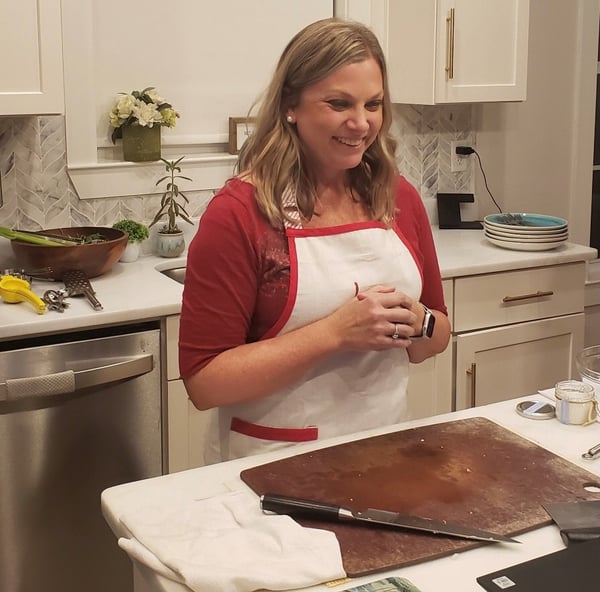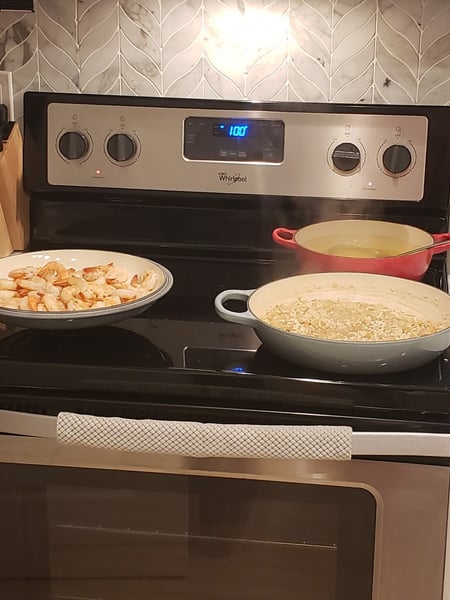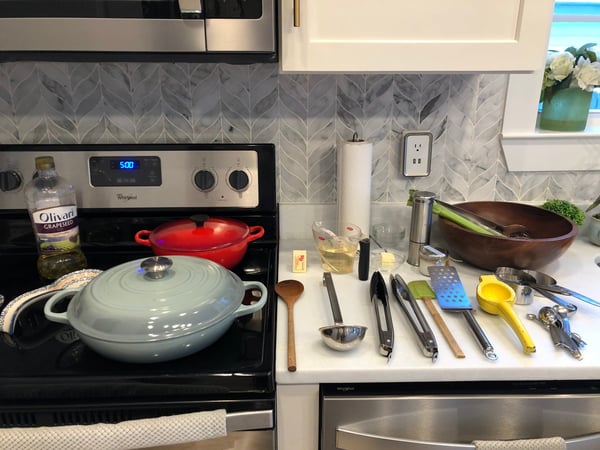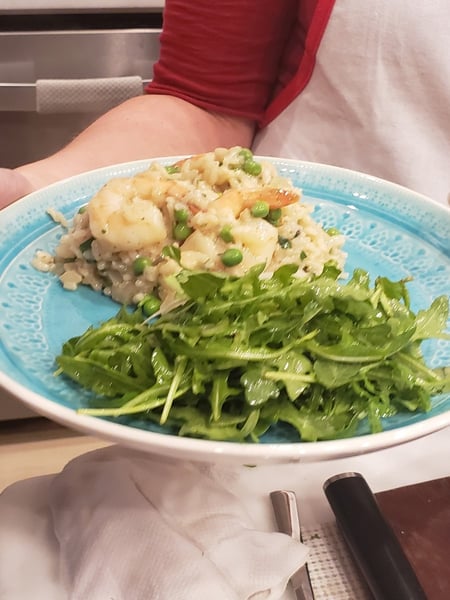Risotto Rules for an Impressive Dish

Risotto is always a popular dish in our cooking classes, and I love making it for dinner parties and giving tips to my friends. Knowing how to make a good risotto is something I think every home cook should have in their back pocket, if only because it’s one of those dishes that’s so satisfying and easy to prepare, and it never fails to impress. And while it has a reputation of being fussy and time consuming, it's actually very easy to make. So when my friend recently asked me to teach a virtual cooking class for her VIP real estate clients for Valentine's Day, I knew immediately that risotto would be on the menu.
 Risotto is a dish that originated in Northern Italy. It's known as the “in-law” dish because people use making it as an excuse to stay in the kitchen and stir constantly therefore avoiding the conversation at the dinner table with the in-laws. But that’s a myth. Risotto doesn’t involve babysitting, just some intermittent supervision.
Risotto is a dish that originated in Northern Italy. It's known as the “in-law” dish because people use making it as an excuse to stay in the kitchen and stir constantly therefore avoiding the conversation at the dinner table with the in-laws. But that’s a myth. Risotto doesn’t involve babysitting, just some intermittent supervision.
Another reason I love risotto is that you can adjust the ingredients to whatever is in season (asparagus, mushrooms, caramelized onions, Swiss chard, sausage, pancetta, etc.). The possibilities are endless! Risotto can be a great side to meat or fish entrees or as an entrée itself.
The dish is nothing more than rice, but involves some important techniques. Here are my top ten tips for making a great risotto.
Top 10 Tips for a Great Risotto
1. Always use warm stock.
Warming the broth before adding it to the warm rice coaxes more starch out of each grain of rice and helps prevent it from overcooking. Cool broth takes longer to warm up in the risotto pan and may shock the grain into holding onto its starches while the rice itself continues to cook.
 2. Use a wide pan.
2. Use a wide pan.
Risotto can be made in any heavy-duty pot, but I prefer a pot with a wide base when making risotto, like my Le Creuset braiser. I like a wide base so that the rice cooks evenly and has more surface area to come in contact with the heat. You can also use a Dutch oven.
 3. Use Arborio rice.
3. Use Arborio rice.
We typically use a short-grain rice like arborio rice when making risotto. All rice whether long grain (like basmati, jasmine, etc.) or short grained like arborio contain starches, which define the texture of the rice as it cooks. Arborio rice preserves its firm center as it cooks and the surrounding starch breaks away. It stays intact creating that 'al dente' (aka "to the tooth") chewiness prized by Italian chefs.
You can substitute carnaroli rice (which is very similar to Arborio), farro though you'll get a creamier result, barley and even sushi rice in a pinch. If using sushi rice, don’t rinse it like you would normally do to make sushi and be careful not to overcook it because it can fast become a sticky glop of a mess.
4. Toast the rice.
Toasting the rice for a few minutes is important because it creates a shell around each grain, allowing the grain to slowly absorb moisture without getting soggy.
5. Deglaze with wine.
Adding a crisp, dry white wine that you would drink (think Sauvignon Blanc, Pinot Grigio or an unoaked Chardonnay) to the risotto pan releases any brown bits from the bottom of the pan (called fond and aka flavor), and we cook the alcohol out so the pan should be almost dry .
 5. Watch your time.
5. Watch your time.
Risotto should only take about 18 minutes to fully cook from the time that you start adding the stock. That's no time at all!
6. Stir, but not too much.
Stirring the rice constantly will add air into the risotto, cooling it down and making it gluey. But if you don't stir enough, the rice will stick to the bottom and burn. Agitating the rice is important, because risotto's creaminess comes from the starch generated when grains of rice rub against each other. So stir it often, but feel free to give your arms (and the rice) a break.
7. Add the stock in small increments.
If you dump in the stock all at once, you're just boiling rice. By slowly adding stock, you allow the rice grains to bump up against each other, creating that creamy starch. Wait until the rice absorbs all the stock to add some more. And keep in mind the ratio - about four cups of stock for every cup of arborio rice. I always heat up more stock than I think I made need, just in case. You can always use that extra stock for something else later.
8. Monitor your heat.
After you've sautéed the onions, garlic and toasted the rice on a higher heat, you want the rice to stay at a medium simmer for the entire cooking process. Too low, and the stock will take a long time to absorb into the dish. Too high, and you'll have rice stuck to the bottom of your pan.
9. Use your eyes and mouth to tell when the risotto is done.
The best way to determine risotto doneness is with both your eyes and your mouth. First take a look at the pan. Is the risotto creamy but not thick, rolling back after the spoon is run through the pan? You’re probably very close to done. Now take a bite — the rice should be mostly soft with a small bite on the softer side of al dente.
9. Finish the risotto off the heat.
Finish your risotto with fresh herbs, cold butter and cheese off the heat, then plate. It should mound on your plate rather than running loosely all over the plate.
This TCB classic risotto features shrimp and frozen peas, which is perfect for this time of year. Feel free to experiment with your ingredients based on the season (I can't wait until summer to try this sweet corn version), and have fun!

Risotto with Sautéed Shrimp, Peas and Fresh Herbs
Scroll down for a printable version of this recipe
Yield: 4-6 servings
Active time: 40 minutes
Start to finish: 40 minutes
6 cups chicken or vegetable stock
2 tablespoons grapeseed oil
1 pound raw shrimp, peeled and deveined
Salt and pepper to taste
2 tablespoons butter
1 onion, small dice
2 cloves garlic, minced
1 cup arborio rice
1 cup white wine
1/2 cup frozen peas, defrosted
2 tablespoons fresh delicate herbs of your choice, rough chopped (see note, below)
1/2 cup parmesan cheese, grated
1 tablespoon cold butter
Salt and pepper to taste
1. Heat the stock in a saucepan, and keep over low heat while preparing the risotto base.
2. Heat a heavy, wide pan over medium-high heat, and add the grapeseed oil. Season the shrimp with salt and pepper to taste, and sear in the hot pan until just golden brown on the first side, 2 to 3 minutes. Flip and continue to cook an additional minute. Set aside on a plate.
3. Reduce the heat to medium, and add the butter. Gently sauté the onions until tender. Add the garlic and cook an additional minute. Stir in the rice and toast for 3 to 4 minutes or until lightly golden brown.
4. Deglaze with the wine, scraping free the browned bits of fond from the bottom of the pan, and reduce until the pan is dry.
5. Pour in the heated stock one ladleful at a time, stirring often, until the rice has absorbed the liquid. Continue in this fashion until the rice is al dente.
6. Stir in the sautéed shrimp and peas and cook until heated through, about 2 minutes.
7. Remove from the heat and stir in the herbs, parmesan cheese and butter.
8. Season with salt and pepper to taste, and serve right away.
Note: Parsley, basil and chives are all great options. If you use dill and or tarragon, reduce the quantity to 1
tablespoon as these herbs are stronger in flavor.
Want to learn how to perfect your risotto with the help of a professional chef in our virtual class? Join us for Virtual Mushroom Risotto on Thursday, February 25 at 6pm CST. You'll learn how to make:
- Risotto with Sautéed Mushrooms and Spinach
- Mixed Green Salad with Balsamic Vinaigrette

Risotto with Sautéed Shrimp, Peas and Fresh Herbs
Ingredients
- 6 cups chicken or vegetable stock
- 2 tablespoons grapeseed oil
- 1 pound raw shrimp, peeled and deveined
- Salt and pepper to taste
- 2 tablespoons butter
- 1 onion, small dice
- 2 cloves garlic, minced
- 1 cup arborio rice
- 1 cup white wine
- 1/2 cup frozen peas, defrosted
- 2 tablespoons fresh delicate herbs of your choice, rough chopped (see note, below)
- 1/2 cup parmesan cheese, grated
- 1 tablespoon cold butter
- Salt and pepper to taste
Instructions
- Heat the stock in a saucepan, and keep over low heat while preparing the risotto base.
- Heat a heavy, wide pan over medium-high heat, and add the grapeseed oil. Season the shrimp
- with salt and pepper to taste, and sear in the hot pan until just golden brown on the first side, 2
- to 3 minutes. Flip and continue to cook an additional minute. Set aside on a plate.
- Reduce the heat to medium, and add the butter. Gently sauté the onions until tender. Add the
- garlic and cook an additional minute. Stir in the rice and toast for 3 to 4 minutes or until lightly
- golden brown.
- Deglaze with the wine, scraping free the browned bits of fond from the bottom of the pan, and
- reduce until the pan is dry.
- Pour in the heated stock one ladleful at a time, stirring often, until the rice has absorbed the
- liquid. Continue in this fashion until the rice is al dente.
- Stir in the sautéed shrimp and peas and cook until heated through, about 2 minutes.
- Remove from the heat and stir in the herbs, parmesan cheese and butter.
- Season with salt and pepper to taste, and serve right away.
- Note: Parsley, basil and chives are all great options. If you use dill and or tarragon, reduce the quantity to 1 tablespoon as these herbs are stronger in flavor.

